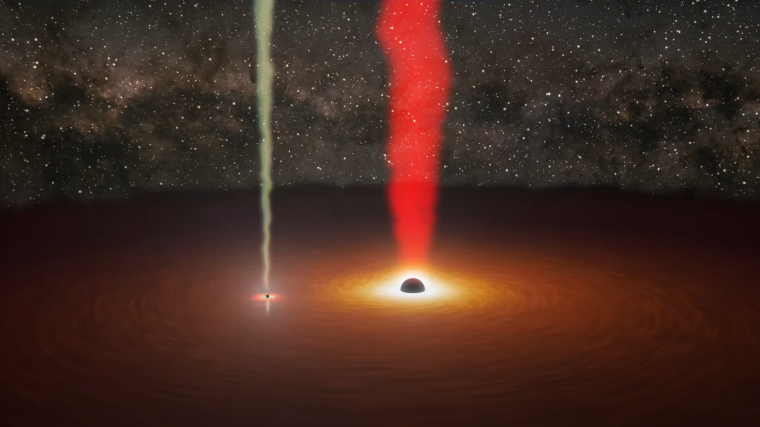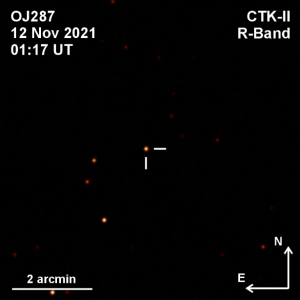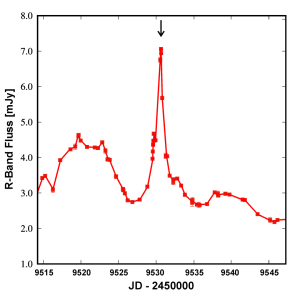
- Light
Published: | By: Ute Schönfelder
Source article
Almost four billion light years away from Earth in the centre of the galaxy OJ287, two giant black holes orbit each other, which are approximately 18 billion and 150 million times more massive than our sun. The larger of the two black holes is surrounded by a vast accretion disk, a rotating disk of matter that flows towards the black hole at its centre.
The brightness of OJ287 is being monitored as part of an international observation campaign in which the University Observatory in Großschwabhausen is also involved. During one orbit, which takes around 12 years, the lower-mass black hole passes through the accretion disc of the central black hole twice, causing massive bursts of brightness that have been observed from Earth several times in the past. But even a few months before crossing the disc of the central black hole, disc material flows onto the companion, which ultimately causes a brief burst of radiation from the black hole's jet of matter.
An international team of researchers, including Dr Markus Mugrauer from the Astrophysical Institute and University Observatory Jena, has now succeeded for the first time in detecting just such a burst of radiation from the jet of the lower-mass black hole. The researchers report on this in the current issue of the "Astrophysical Journal Letters".
Brightness burst only appears for a few hours
OJ287 photographed with the Cassegrain Teleskop Kamera II in the R-band (659 nm) at the University Observatory in Großschwabhausen during the outburst of brightness on the morning of 12 November 2021. The image shows a square field of view with an edge length of 7.5 arcminutes around the galaxy OJ287, which is located exactly in the centre of the image. The other point sources detected are stars in our Milky Way, which are on average several thousand light years away from Earth and therefore about a million times closer to Earth than OJ287.
Image: Markus Mugrauer/Universität Jena"This event can easily be missed if you don't know exactly when it happens," explains Markus Mugrauer. This is because the outburst of the black hole's jet, which can be recognized as a rapid rise and fall in the brightness of OJ287, only occurs within a few hours.
"The fact that we were able to successfully detect the jet burst in this case was only possible because of predictions handed out by modelling the dynamics of this highly relativistic binary system."
The ground-based observation campaign was also supported by space telescopes such as the Transiting Exoplanet Survey Satellite (TESS) and NASA's Neil Gehrels Swift Observatory. In addition, the eruption was confirmed by measurements of the polarization of the light before and after the eruption.
R-band light curve of OJ287 with the detected strong burst of brightness (marked with black arrow), which reached its maximum on the morning of 12 November 2021.
Picture: Valtonen et al. 2024A direct, resolved observation of the accretion discs in OJ287 itself is not yet possible at the present time, says Markus Mugrauer. "Due to the great distance of OJ287, it will probably be a while before the detection methods of astrophysics are developed to this extent."
However, the two black holes could soon reveal their existence in a completely different way. "They are expected to emit gravitational waves in the nano-Hertz range, which can be proven in the coming years with the International Pulsar Timing Array, in particular with the Square Kilometre Array," explains Achamveedu Gopakumar, an astrophysicist from the Tata Institute of Fundamental Research in India, who was also involved in the study. He was previously a research assistant to Prof. Gerhard Schäfer at the Institute of Theoretical Physics at the University of Jena and is currently chair of the Indian Pulsar Timing Array.
Original publication:
Valtonen et al. Evidence of jet activity from the secondary black hole in the OJ 287 binary system, 2024, ApJL 968, L17, https://iopscience.iop.org/article/10.3847/2041-8213/ad4d9bExternal link

